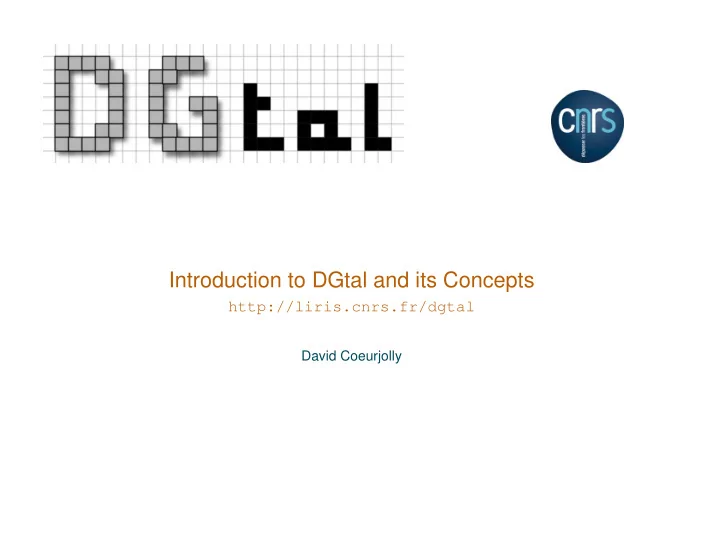

Introduction to DGtal and its Concepts http://liris.cnrs.fr/dgtal David Coeurjolly
DGtal: why Digital Geometry Objectives to make digital geometry easier for the neophyte (student, researcher from another field, . . . ) to quickly test new ideas, with objective comparison wrt existing works to make easier the implementation of demonstrators to help spread our research results to other domains D. Coeurjolly IPOL 2012 Meeting on Image Processing Libraries 2 / 16
DGtal: what for ? Main features to define digital objects in arbitrary dimension to propose algorithms for topological and geometric analysis to provide I/O mechanisms and visualization tools DSS DCA DT Objects Thinning Cellular model 1 0.1 0.01 0.001 Naive 0.0001 BLUE RosenProffitt DSS 1e-05 MLP FP ST l-MST . . . 1e-06 0.001 0.01 0.1 1 Estimators normal vectors Shape DB polynomial surfaces Contours D. Coeurjolly IPOL 2012 Meeting on Image Processing Libraries 3 / 16
DGtal philosophy and structure Genericity and efficiency: C++ library, concepts LGPL cmake build system (linux/macOS/MSwindows), CDash test-suite, doxygen documentation, git, github project, ... user friendly, not necessarily kernel-developer friendly Kernel Package Digital space Point, vectors Digital domains and digital sets . . . Arithmetic Package Fractions Irreducible fractions DSS Pattern.. . . . D. Coeurjolly IPOL 2012 Meeting on Image Processing Libraries 4 / 16
DGtal philosophy and structure Topology Package Digital Topology: connectedness, border, simple points ( á la Rosenfeld) Cartesian Cellular Topology: cells, surfaces and contours ( á la Herman), tracking algorithms Digital Surface concepts and models Geometry Package Primitives ( a.k.a. S EGMENT C OMPUTERS ): DSS, DCA,... Contour analysis: decomposition, convexity, estimators Volumetric analysis: area/volume, distance transforms, reverse distance transforms, Fast-marching methods. Implicit/parametric shape generator for multigrid analysis Math Package Representation of polynoms . . . D. Coeurjolly IPOL 2012 Meeting on Image Processing Libraries 5 / 16
DGtal philosophy and structure Image Package Image concept and Image containers, e.g. Image by STL vector (linearized nD image) Image by STL map (mapping points ↔ values) HashTree image container (generalized octree with hashing functions) IO Package Boards : export to illustrate objects/algorithms (eps,pdf,svg,png,tikz. . . ) Viewers : simple 3D viewer (Qt/QGlViewer) Readers/writers for various image formats D. Coeurjolly IPOL 2012 Meeting on Image Processing Libraries 6 / 16
DGtal 0.5.1 Project started in Jan 2010 200k lines of code env . 557 C++ classes Used in couple of research projects (ANR digitalSnow, collaboration with Chemical lab in Lyon, collaboration INRA at Nancy,... ) D. Coeurjolly IPOL 2012 Meeting on Image Processing Libraries 7 / 16
DGtal principles Generic Programming Data structures ⊥ Algorithms Concepts, models of concepts and concept checking ⇒ C++ with template programming Concepts ? Way to ensure (or to describe) that a type (class) satisfies some constraints (syntactically or semantically). At design level: very helpful to enhance separability data/algorithms At implementation level: concept checking tools to verify that a given type validates a concept D. Coeurjolly IPOL 2012 Meeting on Image Processing Libraries 8 / 16
DGtal program skeleton 1 #include "DGtal/base/Common.h" 2 #include "DGtal/kernel/SpaceND.h" 3 #include "DGtal/kernel/domains/HyperRectDomain.h" 4 ... 5 typedef DGtal::int32_t Integer; 6 typedef DGtal::SpaceND<3, Integer> Space3; 7 typedef Space3::Point Point; 8 typedef HyperRectDomain<Space3> Domain; 9 10 Point p(12, -34,0); 11 Point q(2, -2, -1); 12 if (p < q) 13 ... 14 15 Domain box(p,q); 16 .... 17 D. Coeurjolly IPOL 2012 Meeting on Image Processing Libraries 9 / 16
DGtal program skeleton or even simpler with standard definitions: 1 #include "DGtal/base/Common.h" 2 #include "DGtal/helpers/StdDefs.h" 3 ... 4 DGtal::Z3i::Point p(12, -34,0); 5 DGtal::Z3i::Point q(2, -2, -1); 6 if (p < q) 7 ... 8 9 DGtal::Z3i::Domain box(p,q); 10 .... 11 D. Coeurjolly IPOL 2012 Meeting on Image Processing Libraries 10 / 16
DGtal program skeleton (again) Things to do Fix the dimension 1 Fix the Integer type (commutative ring (+,-,*)) 2 Define the digital space DGtal::SpaceND 3 #include "DGtal/base/Common.h" 1 #include "DGtal/kernel/SpaceND.h" 2 {...} 3 typedef DGtal::int32_t Integer; 4 typedef DGtal::SpaceND<6, Integer> Space6; 5 6 //mpz_class == DGtal:: ← typedef mpz_class IntegerGMP; 7 ֓ BigInteger typedef DGtal::SpaceND<6, IntegerGMP> Space6GMP; 8 Q: what’s wrong with ? typedef DGtal::SpaceND<2, unsigned char > MySpaceUChar; 1 D. Coeurjolly IPOL 2012 Meeting on Image Processing Libraries 11 / 16
[DETAILS] Concept & Models Answer unsigned char does not define a ring ! Constraints on types and template parameters are defined with Concepts Integer in SpaceND should be a model of DGtal::CCommutativeRing . Concept Checking with boost ... 1 //Integer must be signed to characterize a ring. 2 BOOST_CONCEPT_ASSERT(( CCommutativeRing<TInteger> ) ); 3 ... 4 D. Coeurjolly IPOL 2012 Meeting on Image Processing Libraries 12 / 16
Example using Image concepts CTrivialConstImage CTrivialImage CConstImage CImage CBidirectionalOutputRange use Image (main concepts) ImageCotnainerByITKImage ImageContainerBySTLVector ImageContainerBySTLMap ImageContainerByHashTree Image ImageContainerByITK Image (main models) D. Coeurjolly IPOL 2012 Meeting on Image Processing Libraries 13 / 16
D. Coeurjolly IPOL 2012 Meeting on Image Processing Libraries 14 / 16
Main DGtal objects/concepts in one slide CSpace : where all your computations lie, provides you an algebra CPositiveIrreducibleFraction : well.. you get the idea... CDomain : provides you ways iterate on points (classical model: HyperRectDomain ) CDigitalSet : containers of a collection of digital points, provides you iterators, insert/delation methods,... Object : union of a digital topology and a digital set (neighborhood , connected components, simple points test, ...) CDigitalSurface{Container,Tracker} : models to construct/track digital surfaces CSegment : given a 2D generic contour, models which associate a “property” to a part of it CSegmentComputer : refinement of CSegment whose models provides methods to “recognize” part of the curve satisfying the “property” ( e.g. DSS, DCA, ...) CImage : models which associate values to point in a domain. Board2D, Viewer3D, Board3DTo2D : viewers, exporters,... D. Coeurjolly IPOL 2012 Meeting on Image Processing Libraries 15 / 16
DGtal Team http://liris.cnrs.fr/dgtal http://github.com/DGtal-team D. Cœurjolly J.-O. Lachaud G. Damiand X. Provençal M. Tola T. Roussillon B. Kerautret S. Fourey I. Sivignon N. Normand D. Coeurjolly IPOL 2012 Meeting on Image Processing Libraries 16 / 16
Recommend
More recommend